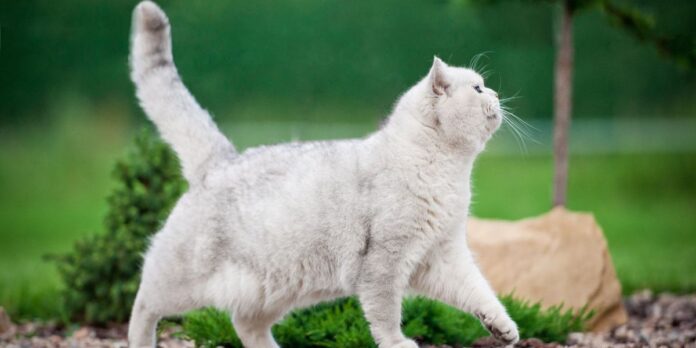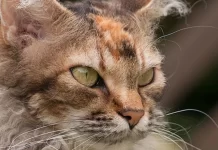Last Updated on November 19, 2023 by Fumipets
Because a cat’s tail is made up of a number of muscles, ligaments, tendons, and nerves that provide cats with a complete range of motion over their tail, cats may deliberately or involuntarily control their tail.
Many cat owners wonder if cats can control their tails or whether it is a response to certain emotions your cat may experience. Cat owners are beginning to pay more attention to their cats’ physical movements. One of the easiest ways to tell how your cat is feeling and what kind of mood they’re in is to learn how cats regulate their tails and what their tail motions indicate.
This article offers all the solutions you want if you have been fascinated by your cat’s tail and inquisitive about what certain tail motions could indicate or even how cats can control their tails.
Understanding Cat Tail
A cat’s extensive network of nerve endings enables it to feel its tail and employ a variety of muscles to regulate its movement without having to think about it. Their many-vertebrae tails, which are an outgrowth of their spinal column, are. This makes the tail sensitive, and your cat may feel and move it totally depending on how they are feeling, such as joy or sadness.
Meowing and the wagging of the tail are the two primary ways cats communicate via body language. Given that cats cannot talk to communicate with their owners, it is important to pay great attention to your cat’s body language to make sure it is generally happy and at ease rather than agitated and distressed. Fortunately, it’s simple to figure out since cats continually regulate their tails in a manner that makes it simple for you as the owner to recognize where your cats’ tails are.

How Are Cats Able To Control Their Tail?
Your cat can control their tail by tipping and flexing certain nerves utilizing the muscles distributed across the base of the tail, and by maintaining the tail’s structure via the tendons and ligaments distributed throughout the tail. The tail of your cat is lean and is naturally moved by their body and nerve system, much as their body is. The brain receives nerve signals that “move” the tail in response to your cat’s emotional or physical condition, which in turn instructs their muscles to “move.”
It’s interesting to note that, like dogs who wag their tails in enthusiasm, cats also move their tails according to how they are feeling. Even though you may have seen your cat wag its tail vehemently, whether it is coiled erect or swinging side to side, the tail does seem to have exact motions.
How your cat moves their tail is influenced by all of the ligaments, tendons, bones, muscles, and nerves in their body. As a result, a cat with a particular nerve, tendon, or ligament injury to its tail may seem to lose some mobility in the location where the injury occurred, giving its tail a kink.
Cats may move their tails in two different ways, namely:
1. Voluntarily
When the cat is aware of their motions and the positions their tails are in, this occurs. Examples include freely swishing their tail, which is often observed when an activity excites them, such as feeding or fun. Your cat moves its tail in accordance with its feelings, whether they are physical or emotional (such as external pains). Your cat is entirely aware of what it is doing with its tail at this very moment.
2. Involuntarily
Your cat’s tail usually wags involuntarily while it’s sound asleep. They may swish or flick their tail mostly as a result of a dream they are experiencing that causes them to experience a certain mood. Your cat’s tail could sometimes move as a response when they experience a startling shock, for example.
Why Do Cats Move Their Tails?
Your cat will mostly move its tail for communication purposes. In addition to being a choice reaction to how they are feeling, it also facilitates cat or dog communication since body language is crucial for animal communication. When they are nervous or aroused, cats will sometimes move their tails while speaking, but when they are calm and satisfied, they seldom ever do so.
- Non-verbal communication
- Involuntary reaction to a feeling during sleep
- Voluntary reaction to mood
- To communicate with other felines
What Do Different Cat Tail Movements Indicate?
Our feline companions’ tail control might be a reliable indicator of their emotional state. With the exception of sleeping cats, every action is deliberate and exact.
The tail of a contented cat will wag in a comfortable manner, with the tip curled in slightly. This demonstrates how joyful and enthusiastic they are feeling. When kittens are playing with their favorite toys, you can see their tail wagging visibly.
Cats will softly flick and wag their tails when they are feeling at ease and asleep in their surroundings, usually when they are curled up in a cozy area.
This may be noticed in cats who are feeling agitated by an environmental disturbance, such as loud sounds or disruptions from outsiders and other pets in the home. If your cat is rigidly flicking the tip of its tail forth and backward, something in the environment may be piqueing their attention.
Your cat may be extending a welcome or seeking human contact if its tail is pointing straight up with the tip curled forward. This might help to explain why your cat may wave its tail in this manner when you return home or if you haven’t seen them in a long.
Your cat may wander about with its tail up in the air and slightly curved in the center if it is feeling self-assured. This demonstrates that they are content with their surroundings and at ease enough to roam about freely and take part in whatever going on around.
However, a scared cat could have its tail firmly pointing in the air and sometimes with its hair sticking up close to the base, signalling that something about their surroundings is not making them feel happy or comfortable. The cat is still attentive and involved. This is often seen in cats when they encounter an unknown dog or cat because they perceive a danger.
Dr. Ernie Ward, a veterinarian, claims that certain cats may “wag” their tails when they are ill or in discomfort. It is a good idea to take your cat to the doctor for a checkup if you do notice that they are acting strangely, wagging their tail, or hiding more often.
Interesting Facts About Your Cat’s Tail
In spite of having just a stub for a tail at birth, cats will nonetheless move the portion of the stub that is left depending on how they are feeling, further demonstrating that tail control is an innate biological reaction to stimuli. This illustrates how significant a cat’s tail is in terms of its body language, even if it won’t seem as elegant as a cat with a completely functioning tail. This also holds true for cats whose tails have been wounded or amputated.
Cats are very nimble because their tails aid them in balance and coordination.
Your cat may suffer irreversible harm if its tail is injured. Remember that because your cat’s tail connects to its spine, injuries might affect how mobile your cat is. A doctor should determine if the injuries are serious enough to have affected your cat’s spinal vertebrae or neurological system.
The tail of your cat, which has 19 to 23 vertebrae, contains around 10% of its total number of bones.
While a dog’s tail is clearly wagging in enjoyment, cats exhibit the opposite behavior.

Conclusion
It’s interesting to learn how much control your cat has over its tail. When you engage with your cat and want to know whether they appreciate a certain activity or just plain becomes upset by it, this enables you to physically observe how they are feeling emotionally. You can learn more about your cat’s nonverbal communication skills and have fun watching how it moves and manipulates its tail.
https://www.youtube.com/watch?v=Av7MOq_GGdc


















